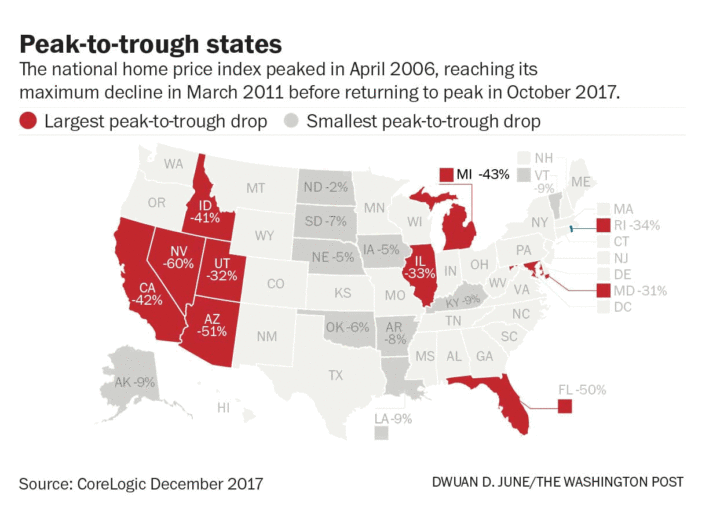The Washington Post had an article looking back 10 years later: How the housing market has changed since the crash. Inside was an interesting map of where the home prices crashed the most and the least (click to enlarge):
I wish they had a similar map that shows how much each individual state has also rebounded from the bottoms. According to this NYT article, the national median price is up 44% over the last 6 years:
When the housing bubble burst a decade ago, property values dropped by as much as 60 percent in some areas. Millions of Americans lost their homes to foreclosure. Nationally, the median price of existing homes today is $269,600 — up 44 percent in the past six years.
There are so many local variations. The house that we bought in 2007 was supposedly near the market top, but today the market value is still probably worth 50% higher. That’s far behind stock market returns, but you also have to consider that we could have bought that house with a tiny downpayment. If you put $40,000 down on a $400,000 house and it goes up to $600,000, then you roughly quadrupled your money (after fees). This goes right along into the conclusion of the WaPo article:
Among the lasting fundamental changes brought about by housing crisis, says Sharga, is that people today look at a home as place to live, not as an investment.
“It’s important to realize that homeownership is something to aspire to, but it’s also important to be ready for it,” he says. “It can be a wealth builder, but, as we saw, it can also be the quickest path to financial devastation if you’re not prepared.”
You can still buy a house with zero to 3.5% down payment these days, and that’s big leverage. Leverage goes both ways. It can make you rich much more quickly, but it can also make you broke much more quickly.

 The Best Credit Card Bonus Offers – March 2024
The Best Credit Card Bonus Offers – March 2024 Big List of Free Stocks from Brokerage Apps
Big List of Free Stocks from Brokerage Apps Best Interest Rates on Cash - March 2024
Best Interest Rates on Cash - March 2024 Free Credit Scores x 3 + Free Credit Monitoring
Free Credit Scores x 3 + Free Credit Monitoring Best No Fee 0% APR Balance Transfer Offers
Best No Fee 0% APR Balance Transfer Offers Little-Known Cellular Data Plans That Can Save Big Money
Little-Known Cellular Data Plans That Can Save Big Money How To Haggle Your Cable or Direct TV Bill
How To Haggle Your Cable or Direct TV Bill Big List of Free Consumer Data Reports (Credit, Rent, Work)
Big List of Free Consumer Data Reports (Credit, Rent, Work)
Speak Your Mind